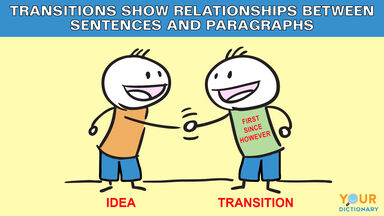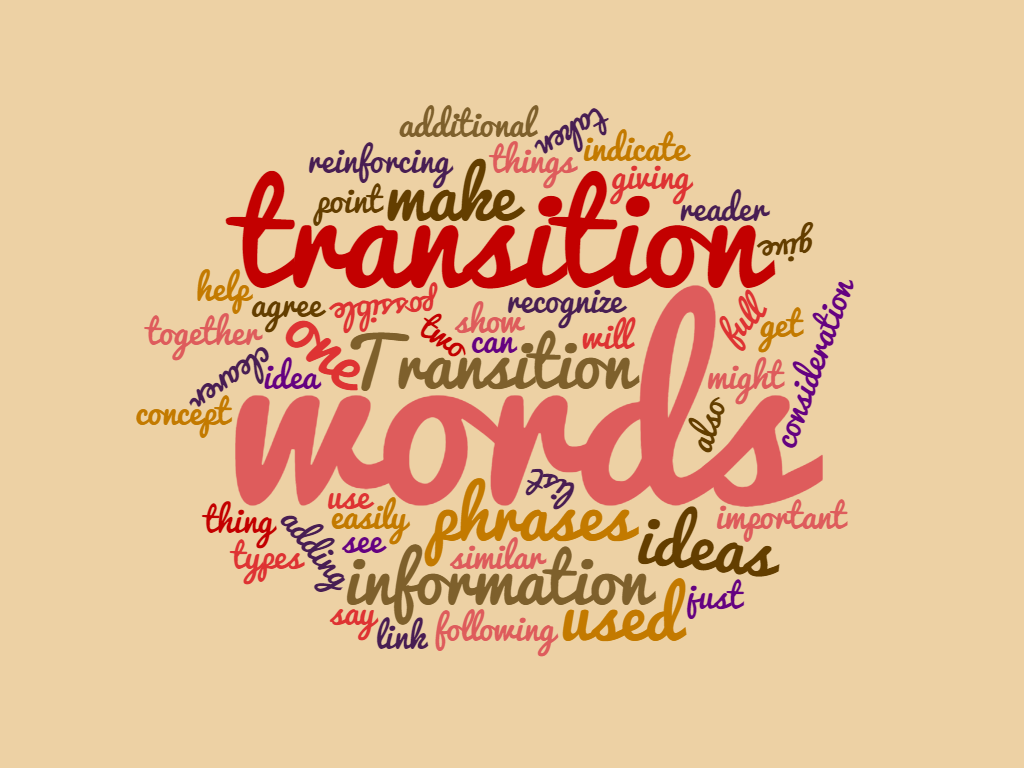Transition Words or phrases are “connecting” words and phrases. They do more than just creating the flow for your content, more importantly, they keep your readers reading which is what's important for SEO. Learn more transition words and find out how you can use them to improve your readability.
It might come unsaid but writing a readable blog post is an essential part of every SEO strategy. It’s nothing but a pure simple concept. To create content that flows naturally, you must master the use of transition words.
In other words, using transition words can help improve the readability of your content. Content readability simply being the measure of how easy your audience can understand your articles.
As a marketer, it is essential to ensure that your content is written for your visitors and not just bots. If your copy is hard to understand, your traffic will consider it irrelevant, and they will shift to competitor sites.
What are Transition Words?

Transition words are terms that link ideas. They show a relationship between paragraphs, phrases, and sentences. What’s more, they prepare your reader for what is coming.
Let’s consider this example.
Many people are now shopping online. Consequently, you need to invest in digital marketing.
By including ‘Consequently’, it shows how your second sentence is related to the first. Without reading the remaining part, your visitors can anticipate what is coming.
Now let’s look at the sentence without the transition word, it will read:
Many people are now shopping online. You need to invest in digital marketing.
Just a lack of transition word and the two sentences start to look disjointed and without purpose.
Of course, a transition is not just limited to just words, they can also be phrases that help writers bridge two or more sentences, paragraphs, or sections of your content together.
Also known as words for transition, these words provide content creators with additional context to help readers’ link information together.
Essentially, transition words help readers to piece together sentences and paragraphs to enable them to see the bigger picture.

Moreover, they provide organization and structure to your content to make it much easier for the readers to comprehend.
What Are Some Examples of Transition Words?
As aforementioned, transition words give your content that magical touch to give it an edge over other competitor websites.
While using transition words between paragraphs and sentences won’t impact your overall page rank on SERPs, it improves your post’s readability, which ultimately contributes to better ranking.
Some examples of transition words types:
- Additive transitions: used to show addition, similarity, introduction
- Adversative transitions: used to show contradiction concession, dismissal, conflict
- Causal transitions: used to signal reason/result and cause/effect, etc.
- Sequential transitions: used to signal a logical or chronological sequence
Using the correct transition words like “and,” “but,” and “because” can help make your content easier to understand and give the reader an idea about what you are writing about.
On the other hand, using words like “conclusion” in your post inform the reader that you are concluding your copy.
How are Words for Transition Important to SEO?
It’s almost impossible to overstate how important transition words are when it comes to language and readability.
Ultimately, transition words play a significant part in leading readers from one paragraph to another, before reaching the final point.
Nobody is going to disclose all the secrets in the first paragraph. So, your content should always be designed is to keep the reader reading till they reach the very end. And that’s what makes transition words or phrases so important in SEO writing.
By now, you should understand thedefinite correlation between transition words and SEO. Using them in your text will certainly help to improve your context’s readability and structure.
When used appropriately and in the right context, these words can add spice to your content and make it feel more interesting to read. And that is every content creator’s goal.
Regardless of search engine optimization and inserting keywords, you want the reader to stick to your post and read it to the end. Because Google will love you for it!
The more “readable” your post is, the more engaging users will likely find it. Meaning they will linger on your content for longer, which is one of the main metrics search engines consider when ranking websites.
Also, there are no downsides to making your post easier to read. Content readability is such an important factor in writing that popular plugins like Yoast SEO and SEOPressor WordPress plugin have specific readability scores.

We can’t say it enough. Using transition words appropriately is one of the best ways of making your content easier to read.
However, like everything else, that doesn’t mean you cram as many transition words into your content as you can.
It’s an invitation to pay close attention to how you use these magic words and possibly expand your vocabulary. So next, we will guide you on how you can use transitional words with more flare.
Types of Transitional Words
There are over 200 different transitional words and phrases that you can use in your content to improve its structure and readability.
Here’s a comprehensive list of some common words for transition you can use in your posts:
Agreement/Addition/Similarity

These are some of the most common words in the English language. Almost everyone uses them to reinforce their points or expound upon them. Some common examples include:
- Also
- Again
- Like
- Not to mention
- In addition
- Besides
- Together with
- By the same token
- Identically
- To say nothing of
- In the same fashion
- Of course
- Likewise
Opposition/Contradiction/Limitation

Conflict is everywhere, writing included. Some of its prime examples are evident in opposition or contrast words. These include:
- Besides
- Despite
- Instead
- Although
- In contrast
- Whereas
- Otherwise
- Even though
- Above all
- In reality
- Of course…, but
- On the other hand
While their connotation may be negative, opposition transition words are meant to highlight differences between ideas. They are more of a net positive as you can use them to introduce topic and content shifts in your writing as well.
Cause/Condition/Purpose

These phrases represent specific intentions or conditions. Examples include:
- If
- As
- Since
- Because of
- Unless
- Whenever
- … then
- To the end that
- For fear that
- Being that
- In view of
- Given that
This category of transitional words is essential in almost all types of content you might want to write.
Examples/Support/Emphasis

These transitional phrases introduce evidence or add emphasis to your content, which in other words highlight your content. Examples can often bring your points and arguments to live. Some common words and phrase to introduce your examples in include:
- Like
- Notably
- Truly
- Specifically
- To be sure
- Like
- Including
- To demonstrate
- Another key point
- Certianly
- To repeat
- Notably
Effect/Consequence/Result

Some of these transitional words are time words that show what transpired after a particular time, and their consequences/effects. Examples include:
- Thus
- Then
- Accordingly
- Consequently
- Therefore
- Henceforth
- As a result
- Under those circumstances
- That’s why
- In that case
- For this reason
- Accordingly
Other consequence/effect transitional words are placed before the reason/cause. Examples include:
- For
- Because
Conclusion/Summary/Restatement

It’s always wise to inform the reader of a recap of important points in your post. In this case, summary transition words are your best ally. Some common examples include:
- Therefore
- In short
- As a result
- Finally
- In conclusion
- The key takeaway
- In conclusion
- As a whole
- All things considered
- Obviously
- Ultimately
- By and large
- In the long run
These phrases can help you cover important concepts more quickly and concisely, making them effective for use even in the middle of your post.
Time/Chronology/Sequence
These transition words are crucial when trying to inform the reader of a series of events that are dependent on time. These events may have already occurred or will occur sometime in the future. Examples include:
- Meanwhile
- Afterward
- Eventually
- Formerly
- At the same time
Space/Location/Place
References to space are very common in most types of writing. To mean that you will have a broad range of relevant transitional words to draw from, including:
- Across
- Where
- Before
- There
- Here
Whether your content requires you to describe a physical space, or just instruct the reader on where to add a code, space transition phrases are vital to clarifying information.
Master Your Transition Words for SEO writing
As words that carry the reader between different ideas, transition words help the reader to see the relationship or connection between ideas. Just as important, they also help to prevent sudden jarring mental leaps in your content.
Readability Is Important
Content readability represents how easily readers can understand your written content. Transitional words make it easier for your visitors to read and understand your post. Content readability is vital for SEO, making your use of transition phrases all the more important.

This is where our tool BiQ SEO suite comes in. It can help you break down your content’s ease of readability paragraph-by-paragraph and let your know who you are writing for, as well as your tonality and emotion.
Perhaps you are writing a 2,000-word blog post that should supposedly be easy to read with a positive outlook, you can just run it through BiQ and save your time fixing only the paragraphs that do not fit the description.
Transition Words Structure Your Content
Transitional words also play a vital role in structuring your content. Ultimately, this will lead to the reader’s better understanding of your text.
So when you are outlining your content, take into consideration what is the flow of your content. A well-structured text will attract even more readers and contribute to your SEO!
3 Steps to Improve Your Use of Transition Words
Everyone uses words for transition in one way or the other. However, using them correctly and frequently enough doesn’t come naturally to everyone. To be successful in your use of transitional words, you have to:
Broaden Your Transition Words Vocab
Knowing the transitional words and phrases is one of the most common problems for writers, especially for non-native speakers.
In any case, however, this post has compiled a list of some of the most common transition words you can use and their classifications.
Remember also that transition words can create confusion if used out of context. Furthermore, you want to make sure you don’t repeat the same transitional words over and over again.
In that case, using synonyms may just be your best friend but bear in mind that different transition words bear different emotions. Just like the two words, “consequently” and “that’s why“.
Although both words convey a cause and effect relationship, each are use in different types of writing. Consequently simply sounds too formal, and that’s the reason why we rarely see it in blog posts.
To check your content, again we specifically recommend using our BiQ’s Content Intelligence. Just paste your link and it will start analyzing your readability, tonality, as well as your contextual relevance to see if your content is on par with the top-ranking results.

Be Aware of the Relationship
Knowing the right transition words to use in your content is only always half the job.
The next step involves your use of these words. You must know the relationship between these words and how you can use them to improve your content’s readability and structure.
Avoid using the transition word if you do not truly understand them.
Avoid Overusing Them
Editors and online readers notice this mistake often, which can harm your content’s credibility and readability. Most writers overuse transition phrases to try and compensate for their limited language skills or a lack of knowledge in using the words themselves.
Overusing transitional words can make your work more difficult to read and understand, which might put off the reader.
You want to use just enough transition phrases to make your content interesting, but not too much to make it difficult to understand.
Key Takeaway
In short, transition words are vital for improving your content’s readability and structure.
Though many still struggle with overusing or the lack thereof transition words, remember it takes regular practice and consistency to perfect your use of these magic words.
To summarize, the focus of SEO content is to create user-friendly text, so always bear in mind readability is important. We hope these words for transition can come in handy!




